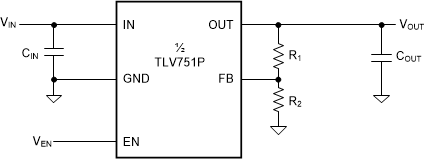JAJSI89B December 2019 – April 2020 TLV751
PRODUCTION DATA.
8.2 Typical Application
Figure 42 shows the typical application circuit for the TLV751. Input and output capacitances must be at least 1 µF.
 Figure 42. TLV751 Typical Application
Figure 42. TLV751 Typical Application JAJSI89B December 2019 – April 2020 TLV751
PRODUCTION DATA.
Figure 42 shows the typical application circuit for the TLV751. Input and output capacitances must be at least 1 µF.
 Figure 42. TLV751 Typical Application
Figure 42. TLV751 Typical Application